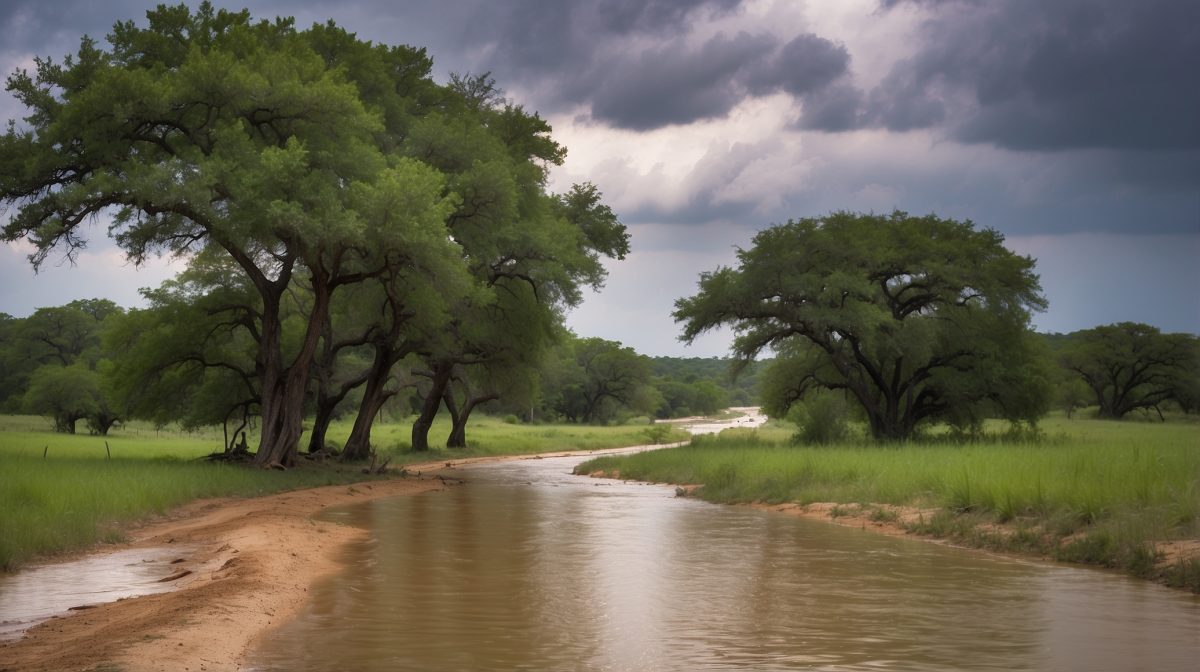Our Hill Country is a gem, with landscapes that’ll take your breath away and weather that can change quicker than a jackrabbit on a date. But there’s more to our weather than just sunshine and blue skies. You see, Flash Flood Alley is a term as serious as a heart attack, and it’s mighty significant to folks living and visiting here. It’s about understanding the lay of the land and the skies above. So let’s mosey on through the ins and outs of what makes our neck of the woods a hotspot for these rushing waters.
The Geography of Texas Hill Country
Picture this: rolling hills stretching as far as the eye can see, limestone cliffs catching the sunset, and a tapestry of plants and critters that’s as diverse as the great state of Texas itself. That’s the Texas Hill Country for ya. But it ain’t just a pretty face. The same topography that gives us these beautiful views also sets the stage for water to come barreling down faster than a bull at a rodeo when heavy rains hit. It’s all about the slopes and the soil, folks.
Now, our land here is made up of a whole lot of limestone bedrock, which, bless its heart, isn’t the best at soaking up water. When the heavens open up and the rain pours down in buckets, that water’s got nowhere to go but racing off those hills and valleys. This creates a rapid runoff situation that can turn a dry creek bed into a raging torrent in the blink of an eye. It’s nature’s way in these parts, and it’s why Flash Flood Alley is a name that sticks.
Historical Flash Floods of Note
Let me tell ya a tale or two about some floods that have swept through these hills, leaving stories in their wake that are told to this day. There was the flood of ’98, a real gully washer that swept through and rearranged the landscape like a deck of cards in a twister. Homes, bridges, and lives were swept up in the deluge, and it’s a reminder to us all of the power that water wields in the Hill Country.
Then there’s the legend of the flood back in the 1800s, where it’s said the water rose so high, cattle were found in trees. Whether it’s fact or tall tale, it goes to show that flash floods are a part of our heritage here. They shape our land and our stories, and they remind us that while we can tame the land to a point, nature will always have the final say.
Meteorological Factors Contributing to Flash Floods
Now, let’s talk about the weather patterns that stir up these flash floods. The Texas Hill Country sits right where the humid air from the Gulf of Mexico meets the dry desert air from the west. When they tangle up, it’s like a dance hall brawl that can unleash a torrent of rain in no time flat. And with our ground being as thirsty as a cowboy after a cattle drive, it doesn’t soak up water too well, leading to those flash floods we’re talking about.
It’s a combination of factors, really. The dry soil, the sudden heavy rains, and our rolling topography all join forces to create the perfect storm for flash flooding. And when those skies darken and the rain starts to fall, you can bet your boots that the water will come a-rushing down those hills, filling up creeks and rivers faster than you can say “hold your horses!”
The Human Element
Now, we can’t talk about flash floods without tipping our hats to the human element. As more folks have come to call the Hill Country home, we’ve seen our fair share of changes. Cities and towns have grown, and with them, more concrete and less open land to soak up that rainwater. It’s like putting a lid on a pot of boiling water – sooner or later, it’s gonna spill over.
But it ain’t all doom and gloom. Take the JL Bar Ranch Resort, for instance. They’re a shining example of how to manage the land with care and respect. By preserving natural landscapes and being mindful of how they develop the land, they help keep the water where it ought to be. It’s about being good stewards of the land, and that’s something all of us in the Hill Country take to heart.
Safety Measures and Preparedness
When it comes to staying safe from flash floods, a little know-how goes a long way. First off, always keep an eye on the weather, especially if them clouds start looking like they mean business. Have a plan in place for you and your kin, know where to go if you need to get to higher ground, and never, ever try to cross a flooded road. That water’s more treacherous than it looks, and it’s not worth the gamble.
It’s also smart to stay informed with alerts from local weather stations and emergency services. They’ll give you the heads up when floodwaters might be headed your way. And remember, in these parts, it’s not just about being prepared, it’s about being smart. Respect the power of nature, and don’t take chances when the rains come pouring down.
Conclusion
So there you have it, folks. The Texas Hill Country is a land of beauty, charm, and a little bit of wild weather thrown in for good measure. Flash Flood Alley is part of what makes this place special, a reminder of the power and majesty of Mother Nature. We’ve got a history that’s as rich as the soil and a spirit that’s as resilient as the oak trees that dot our landscape.
At the end of the day, it’s about respecting this land we call home and understanding the forces that shape it. Whether you’re a lifelong resident or just passing through, remember that Flash Flood Alley is a testament to the beauty and resilience of the Texas Hill Country and the folks who live here. Y’all stay safe now, and keep an eye on those skies.
FAQs
What exactly is a flash flood, and how quickly can they occur in the Texas Hill Country?
A flash flood is a rapid rise in water levels, usually caused by intense rainfall over a short period, and in the Texas Hill Country, they can happen in just minutes.
Are there particular times of the year when flash floods are more common in this region?
Yes indeed, flash floods tend to be more common during the spring and fall when the weather can be particularly unpredictable.
How can I stay informed about potential flash flood risks when I’m visiting the Hill Country?
Stay updated by checking local weather reports, signing up for emergency alerts, and keeping an eye on the sky when you’re out and about.
What should I do if I find myself caught in a flash flood situation?
Seek higher ground immediately, do not attempt to cross floodwaters, and call for help if you’re in a dangerous situation.
How are local businesses like the JL Bar Ranch Resort involved in flash flood safety and preparedness?
Businesses like the JL Bar Ranch Resort play a role by managing their land responsibly, supporting local flood mitigation efforts, and ensuring the safety of their guests and staff.


